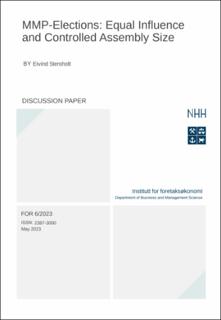| dc.description.abstract | In an MMP election (Mixed Member Proportional) of a legislature, a QP-ballot supports party Q in a single-seat constituency and a list of candidates from P. With ꙍ(j) constituency seats won and list support in z(Pj) ballots, party Pj
wins α(j) list seats, so that ꙍ(j)+α(j) becomes proportional to z(Pj).
The pivotal party, Pj*, has the highest of all ratios ꙍ(j)/z(Pj). Proportionality implies, for all Pj passing some threshold, that [ꙍ(j)+α(j)]/z(Pj) ≥ ꙍ(j*)/z(Pj*).
In the smallest proportional assembly, all ≥ are equalities and α(j*)=0.
The pivotal party’s list support, z(Pj*), is naturally volatile. An election with α(j*)=0 tells that z(Pj*) list votes were wasted, and many voters learn it. Thus, between Bundestag elections 2017 and 2021, z(Pj*) dropped significantly. The smallest possible size of a proportional assembly rose from 709 to 794 seats, while the legal norm is 598.
But an ad-hoc law of 2020 abandoned the proportionality rule, shrinking the assembly from 794 to 736 seats.
ꙍ(j) measures and records the success of party Pj in the single-seat tallies; it also records how much α(j) is reduced by Pj’s constituency success. The paper compares this”traditional accounting” and“faithful accounting”: The latter records a QiPj-ballot, with Qi as constituency winner, with a tiny seat fraction that reduces α(j). Traditional accounting treats party Pj as a basic entity. Faithful accounting replaces it by the set Λ(Pj) of voters with list vote for Pj.
This is a paradigm shift: Traditional accounting works even if constituency votes and list votes are collected in separate ballot boxes. But in faithful accounting, each ballot’s combination of Qi and Pj is essential.
Main results: The change from traditional to faithful accounting brings the assembly size under control. A large inequality in voters influence is substantially reduced. | en_US |
